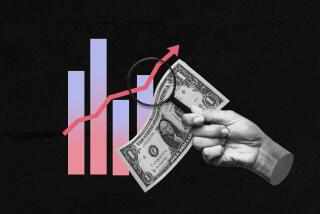Industry Is Finally Moving to Woo Latinos
- Share via
Imagine reading something as complicated as a mutual fund prospectus in a foreign language.
That’s the problem faced by Americans for whom English is a second language. Most notable is lack of investment material in Spanish--the primary or only tongue for about 9% of the U.S. population.
Only in the last few months has there been any real movement by fund companies to make their marketing efforts bilingual--and much more is needed, critics say.
“Most mutual fund companies have no idea of the size of the Hispanic market,” says Luis Anon, senior manager of Price Waterhouse’s mutual-fund consulting group in New York. “A lot of potential investors are being ignored.”
Not only is it hard to find bilingual prospectuses and other marketing literature, most fund companies don’t have many Spanish-speaking telephone reps, says Anon, an immigrant from Cuba.
“That’s why I got interested in this subject. About a year ago, my own folks wanted to invest in some mutual funds, but nobody (at the fund groups) could speak to them,” he complains.
It’s also difficult to locate Spanish-language investment newsletters, research materials and advisory publications providing impartial financial analysis, he says.
In Anon’s view, this information shortage, more than other factors such as income, explains why only 2% to 3% of Latino households own mutual funds, compared to 25% for the U.S. population overall.
He cites data from Strategy Research Corp. of Miami that shows that Latino households on average earned an estimated $32,400 in 1991, compared to $37,400 for non-Latino households--a gap of less than 15%.
*
While many Spanish speakers can communicate well in English, most rely primarily on their native tongue when making complex investment decisions, Anon says.
Although the vast majority of fund families haven’t translated their marketing materials into Spanish, there are notable exceptions.
The AARP Investment Program from Scudder offers seven mutual funds--all with bilingual prospectuses and brochures. The AARP portfolios cater to investors 50 and over. They can be ordered by calling 800-253-2277, extension 4281.
The 11 funds in the GW Sierra Trust family (800-222-5852) also have Spanish prospectuses and brochures.
The Los Angeles-based fund group spent $250,000 to translate, print and legally review these documents, but the costs have been justified by a strong investor response, says Mary Anne Houlahan, a senior vice president for GW Sierra. “People absolutely love it,” she says of the bilingual material. “This is a service a lot of other companies seem to be missing.”
It’s worth noting that fund management companies, not existing shareholders, bear the costs of translating prospectuses and brochures into Spanish. A few other groups have Spanish translations for one or two portfolios but not their entire lineups.
For instance, Colonial Mutual Funds (800-248-2828), which offers 29 mutual funds, has translated material only for its U.S. Government Trust. And Dreyfus Funds (800-882-LEON, 800-645-6561), which manages 110 funds, has a Spanish prospectus/brochure kit for only one fund--Worldwide Dollar Money Market--although bilingual material will soon be available on Dreyfus’ Growth & Income portfolio.
(Dreyfus also has some Mandarin Chinese literature available on Worldwide Dollar at its San Francisco investment center, which can be reached at 415-777-5522.)
*
Both fund companies appear to want to introduce novice Latino investors to the mutual fund realm using low-risk products--a wise idea, in Anon’s view.
“Because the Latin American investment climate is less secure than it is here, Hispanic investors appear to be relatively conservative,” he says.
Latino Marketplace
Latinos account for 9% of the U.S. population but only 2% of mutual fund sales. Some fund companies want more of their business.
*1990 population: 22.4 million (9% of U.S. total)
*1991 mean household income: $32,400 (87% of U.S. average)
*1991 disposable income: $182 billion (4% of U.S. total)
*Percentage of individuals who own these financial products:
Savings account: 43%
Checking account: 39%
Certificates of deposit: 4%
IRA/Keogh accounts: 2%
Mutual funds: 1%
Stocks: 1%
Sources: Strategy Research Corp., Miami; U.S. Census Bureau.
More to Read
Inside the business of entertainment
The Wide Shot brings you news, analysis and insights on everything from streaming wars to production — and what it all means for the future.
You may occasionally receive promotional content from the Los Angeles Times.










